|
By Jayden Jech, DNR, Loon Specialist
As spring quickly approaches, the calls of the common loon will shortly be returning to the land of 10,000 lakes!
The Minnesota Loon Restoration Project is working with federal agencies and partners to support loon conservation and restoration in Minnesota. We are excited to be working across the state to support stewardship of our state bird.
In Minnesota, loons rely on healthy lakes and shorelines for nesting. Protecting natural shoreline areas and restoring your lakeshore can improve lake habitat for loons and other wildlife!
Natural Shorelines
Natural shorelines are valuable in keeping lakes healthy and providing habitat for loons and other wildlife. Not to mention, protecting natural shorelines is often easier than shoreline restoration. For additional information, please visit our Maintaining and Restoring Natural Shorelines page.
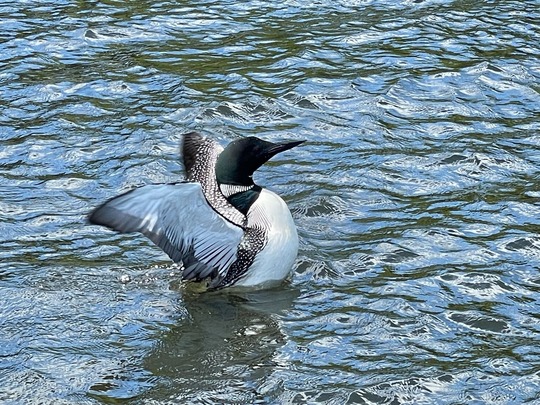 Photo source: DNR Nongame Program
Shoreline Restoration
For previously altered or developed shorelines, restoring your shoreline with a buffer of native plants can support habitat for wildlife, reduce erosion, and more! For additional information, visit DNR's Restore Your Shore page.
Additionally, your local soil and water conservation district or watershed district may have more information specific to your area. Most offer technical assistance and some have cost-share grants.
Shoreland Management
Understanding rules and regulations for your shoreline is extremely important. Permits from the MN DNR or local government unit may be required for shoreline alteration. Visit DNR's Shoreland Management Program page to learn more.
For more information
Restoration of Common Loons in Minnesota is funded by the Open Ocean Trustee Implementation Group through the Natural Resource Damage Assessment Deepwater Horizon settlement.
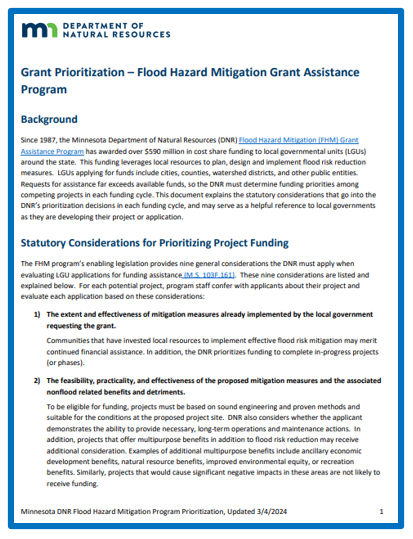
The DNR recently rolled out a new Grant Prioritization document that is designed to provide transparency to the DNR’s funding priorities under the Flood Hazard Mitigation Grant Assistance Program. This document highlights the nine considerations detailed in statute the legislature requires DNR to consider when making funding decisions.
The goal of this document is to encourage applicants to scope their projects in a way that ties into these nine considerations to give them the best chance for funding. DNR staff plan to roll out an updated application form in the next couple of months that more closely ties into these considerations.
The application window is always open, and applicants are encouraged to update their applications as necessary. Ultimately, the biggest priorities for DNR’s funding will continue to be based on the risk being mitigated, need, and the local government’s ability to leverage other funding sources.
For more information
If you have any questions about the Flood Hazard Mitigation Grant Assistance Program or your project’s eligibility for funding consideration, visit the FHM Program web page, or contact the FHM Program Manager Matt Bauman (651-259-5691).
|

Come learn in person and interact with other local officials and professionals involved in aspects of floodplain management (i.e., surveyors, consulting engineers/planners, Realtors, lenders/agents).
We plan to cover floodplain management basics and FEMA map basics, including a map reading and interpretation exercise. Other topics include: floodplain administration 101, utilizing web-based flood maps and tools, dealing with nonconformities, making Substantial Improvement (SI)/Substantial Damage (SD) determinations, and community post-disaster responsibilities.
|
Registration
Registration information is available via a link at the top of our training page. You may also use the direct registration links for the dates/locations below.
-
Rochester: May 7, 2024 (Tue); 9 am – 4 pm (8:30 registration): Rochester Fire Station #2, 2185 Wheelock Drive NE, Rochester |Register
-
Brainerd: May 16, 2024, (Thu); 9 am – 4 pm (8:30 registration): Crow Wing County Government Center (Land Services Building), 322 Laurel Street, Brainerd | Register
- Metro location TBD
If you have any questions, contact Ceil Strauss or floodplain.dnr@state.mn.us.
Year-round water conservation is beneficial
With less than half the average snowfall across much of the state and extraordinarily warm winter temperatures, drought conditions in Minnesota have persisted through the winter. Abnormally dry conditions exist throughout the state and about half of Minnesota is in moderate or severe drought.
Minnesota has experienced significant drought conditions each year since 2021. The 2021 drought was the most severe in Minnesota since at least 1988. Drought in 2023 was generally less severe, but some areas of the state experienced conditions comparable to or worse than 2021.
“While climatologists don’t issue forecasts, we want everyone to recognize that, without substantial precipitation this spring, a continuation of widespread drought conditions in 2024 is likely,” State Climatologist Luigi Romolo said.
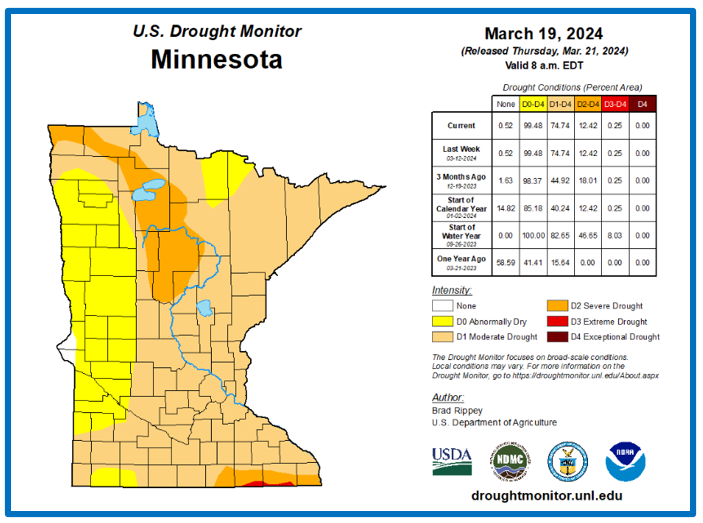 Minnesota Drought Monitor Status (March 19, 2024 update)
Sixty-five surface water appropriation permits remain suspended due to last year's low streamflow conditions. These locations and other watersheds will be monitored closely to support decisions on suspending or reinstating surface water appropriation permits. Surface water appropriation suspensions are implemented when streamflows drop to a low level measurement called the Q90, which is a flow that is exceeded 90% of the time. Weekly streamflow reports typically resume the first week of April.
Recent drought events in Minnesota highlight the importance of year-round efficient water use and conservation. The DNR website has information about what individuals, families, businesses and communities can do to conserve water.
More information about drought is available on the DNR drought webpage.

Back by popular demand!
A series of FREE one-hour virtual trainings on floodplain and shoreland management topics are being offered Dec. 2023 through April 2024. The timing will be similar to our Winter 2023 series, with most trainings offered 1-2 p.m. on Mondays, and 9:30-10:30 a.m. on Wednesdays.
Use the "Register" link next to each training to sign up.
You'll also be able to find the registration links and more details about each training on the DNR Dec. 2023 to May 2024 Upcoming Live Training page, or via the link at the top of the DNR Shoreland and Floodplain Education and Training Center.
Upcoming dates and topics:
|
|
*New topics
-
3/27/2024 (Wed), 9:30-10:30 a.m.: Substantial Damage and Post-flood Responsibilities Register
-
4/8/2024 (Mon), 1-2 p.m.: *Post-Disaster Recovery: Process and Resources Register
|
|
 |
Remember: Recordings of past virtual training available
To see recordings of the one-hour virtual trainings presented in recent years, and other newer on-demand virtual trainings, go to the Shoreland and river-related training page or Floodplain training page.
|
The National Flood Insurance Program (NFIP) has now had dozens of extensions since the last five-year extension that expired Sept. 30, 2017. The latest extension was set to expire March 22, 2024, but on March 23 the President signed legislation passed by Congress that extends the NFIP’s authorization to Sept. 30, 2024.
FEMA's Congressional Reauthorization for the NFIP page should have the latest updates. FEMA reports that they and Congress have never failed to honor the flood insurance contracts in place with NFIP policyholders. Should the NFIP’s authorization lapse, FEMA would still have authority to ensure the payment of valid flood claims with available funds.
|
|
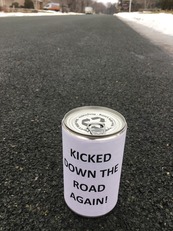 |
|
However, FEMA would stop selling and renewing policies for millions of properties in communities across the nation. Nationwide, the National Association of Realtors estimated in 2017 that a lapse might impact approximately 40,000 home sale closings per month.
|
|
|
 |
FEMA Region 5 staff (based in Chicago) are continuing their monthly one-hour virtual training series in 2023. They are free!
It's not too late to register for many training topics!
Upcoming "Managing your Community's Floodplain" monthly series dates and topics:

Note: All held 9-10 a.m. Central Time.
-
March 27, 2024: National Flood Insurance Program (NFIP) Compliance; Register
-
April 24, 2024: Substantial Damage/Improvement; Register
-
May 29, 2024: Increased Cost of Compliance; Register
-
June 26, 2024: Floodplain Management Higher Standards; Register
These trainings and registration links are also available on the DNR Floodplain Training and Education page.
|

Talk with FEMA and DNR Floodplain Program representatives during monthly virtual Minnesota Floodplain Management Office Hours. Hours are 10-11 a.m., typically on the fourth Thursday of the month (but a few are adjusted to avoid holidays, etc.).
Upcoming monthly hours (Note: all are 10 - 11 a.m. Central Time)
Where: Teams. No registration is required. Select a date to get the Teams meeting appointment.
These office hour dates and links are also available on the DNR Floodplain Training and Education page.
|
Important Dates to Note:
(since Jan. 2024 Water Talk and upcoming in next couple months)
|
|
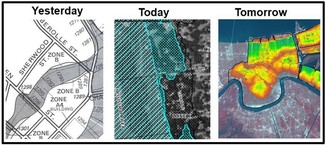 |
Preliminary Maps
- April 2024 - Wabasha Countywide (anticipated)
Local Officials Meetings and Open Houses
- March 27, 2024; 11 a.m. - 12 p.m. - Rock County Revised Preliminary Kickoff (virtual)
- April 30, 2024; 10:30 - 11:30 a.m. - Becker County (Portions) Kickoff (virtual)
90-Day Appeal Periods
- Chippewa Countywide - Feb. 1 to May 1, 2024
Letters of Final Determination (LFDs)
- March 12, 2024 - Stevens Countywide
- March 26, 2024 - Dodge Countywide
- March 26, 2024 - Pope Countywide
Effective (Six months after LFD date)
- April 25, 2024 - Pipestone Countywide
- June 20, 2024 - Wilkin County panels
- June 20, 2024 - Wright Countywide
- July 13, 2024 - Le Sueur Countywide
- July 31, 2024 - Morrison Countywide
- Sept. 12, 2024 - Stevens Countywide
- Sept. 26, 2024 - Dodge Countywide
- Sept. 26, 2024 - Pope Countywide
Additional Map Update Information:
|